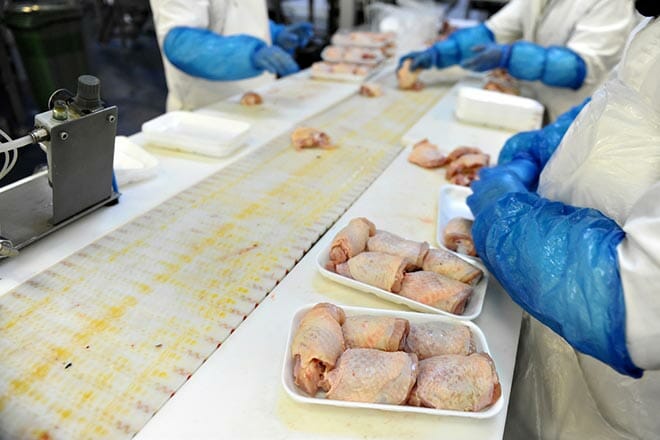Cross-contamination of food products isn’t restricted to processing plants. It is, so to speak, a farm-to-table problem. It can happen anywhere along the production pathway. This paper deals only with cross-contamination in processing plants because they present a special set of problems and solutions.
What is cross-contamination?
Simply put, cross-contamination occurs in food processing plants when contaminants, say Salmonella bacteria or any of many other pathogens and other hazardous materials, come in contact with the product or its constituents and make it a danger to consumer health. The fact that about 3,000 Americans die each year from food-borne illness and 128,000 are hospitalized makes the hazard significant.
Of course, not all these hospitalizations and deaths are the result of failures in the processing plant. Still, those that are tend to get a lot of negative attention. So it’s important to err on the side of safety even if it weren’t simply the right thing to do.
To help keep food safe, processors can follow intersecting avenues:
- Choose the right processing equipment
- Create a food safety plan
- Meet 3-A Sanitary Standards and 3-A Accepted Practices
Selecting processing equipment
All food processing equipment is not created equal. Not only do quality and reliability vary, but different equipment better suits the processing of different foods and different sanitation requirements.
The government and organizations like the American Society of Mechanical Engineers set guidelines for equipment, but they are, of necessity, general. So it’s up to processors to set stricter standards. Then processors can demand that equipment manufacturers meet those standards.
The standards for processing equipment depend on the level of sanitation required. The three levels, high, medium or low sensitivity, give processors a basis on which to work with manufacturers on a comprehensive approach to equipment design and construction. Considerations include “niches” in the equipment where pathogens can become trapped and begin to multiply and how easily and thoroughly a piece of equipment can be cleaned.
Equipment manufacturers source parts from companies like Newark Wire Cloth, maker of SaniClean Strainers. They have a broad choice of standard strainers but also have the option of custom designs to meet specific needs. This flexibility allows for the best design for a given food-processing sanitary requirement. (Insert Image #35364325)
This flexibility is important because of the many factors that affect sanitation, given the nature of the process and the product, such as:
- Surface characteristics (finish, etc.)
- Corrosion resistance
- Environmental temperature
- Composition of gaskets, welds and seals
Developing a safety plan
Food processors have to be ready to handle a food-borne illness outbreak if it occurs, but prevention is the best way to save time, money and, potentially, lives. So a safety plan and adherence to high standards for equipment and production are critical.
In some ways, safety plans will be unique to a particular processor, but there are some general must-haves. For example:
- Pay close attention to design and make changes as necessary
- Set sanitation procedures and controls
- Always monitor processing areas
- Pay special attention to the floors, keeping them clean and dry
- Make sure there’s a way to keep ready-to-eat and raw foods separate

Meeting 3A standards and practices
Three groups—dairy processors, equipment manufacturers and sanitarians—started 3-A Sanitary Standards Inc. (3-A SSI) in 1920 to help keep milk pipefittings safe. There are now 70 standards and they apply to wide range of equipment categories.
To provide standards for the design and installation of processing systems, 3-A SSI established 3-A Accepted Practices. Although 3A SSI has no regulatory authority, the agencies that do use the standards to formulate regulatory codes. The system benefits equipment manufacturers, food processors and consumers alike.
To become 3A-compliant, equipment manufacturers and food processors need expert advice. But once a company has achieved compliance, it’s a strong indication that the equipment in use meets respected standards.
Toward a future without food-borne illness
Preventing food-borne illness is the responsibility of everyone in the “food chain,” but processors are perhaps the most visible part of that chain, so solid standards and practices are particularly important. A future free of this difficult problem is achievable if processors:
- Take the time and make the effort to work closely with equipment manufacturers to design the best equipment for the job and install it properly
- Create a plan that addresses foreseeable issues that affect sanitation in the processing plant, including those arising from the less-obvious sources
- Take control of their individual food-processing procedures by making certain they understand and meet 3-A standards and practices
For more than 107 years, Newark Wire Cloth has specialized in fabricating standard and custom wire mesh products, including SaniClean Strainers for industries such as food processing that must maintain the highest sanitary standards. Contact Newark Wire for more information.
